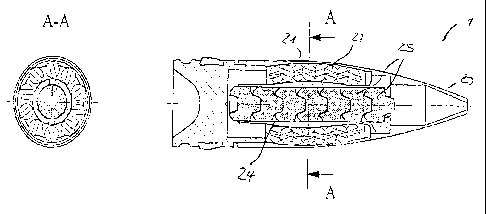Une partie des informations de ce site Web a été fournie par des sources externes. Le gouvernement du Canada n'assume aucune responsabilité concernant la précision, l'actualité ou la fiabilité des informations fournies par les sources externes. Les utilisateurs qui désirent employer cette information devraient consulter directement la source des informations. Le contenu fourni par les sources externes n'est pas assujetti aux exigences sur les langues officielles, la protection des renseignements personnels et l'accessibilité.
L'apparition de différences dans le texte et l'image des Revendications et de l'Abrégé dépend du moment auquel le document est publié. Les textes des Revendications et de l'Abrégé sont affichés :
| (12) Brevet: | (11) CA 2534842 |
|---|---|
| (54) Titre français: | PROJECTILE KE UNIVERSEL DESTINE NOTAMMENT A DES MUNITIONS DE MOYEN CALIBRE |
| (54) Titre anglais: | UNIVERSAL KE PROJECTILE, IN PARTICULAR FOR MEDIUM-CALIBRE MUNITIONS |
| Statut: | Accordé et délivré |
| (51) Classification internationale des brevets (CIB): |
|
|---|---|
| (72) Inventeurs : |
|
| (73) Titulaires : |
|
| (71) Demandeurs : |
|
| (74) Agent: | SMART & BIGGAR LP |
| (74) Co-agent: | |
| (45) Délivré: | 2008-05-06 |
| (86) Date de dépôt PCT: | 2004-11-18 |
| (87) Mise à la disponibilité du public: | 2005-08-11 |
| Requête d'examen: | 2006-02-06 |
| Licence disponible: | S.O. |
| Cédé au domaine public: | S.O. |
| (25) Langue des documents déposés: | Anglais |
| Traité de coopération en matière de brevets (PCT): | Oui |
|---|---|
| (86) Numéro de la demande PCT: | PCT/EP2004/013078 |
| (87) Numéro de publication internationale PCT: | WO 2005073664 |
| (85) Entrée nationale: | 2006-02-06 |
| (30) Données de priorité de la demande: | ||||||
|---|---|---|---|---|---|---|
|
L'invention vise à associer l'effet cascade des pastilles désintégrantes (25) avec des sous-projectiles (27, 28, 30) réalisés en métal lourd ductile, c'est-à-dire à créer une munition (10) qui allie l'avantage, par exemple, des pastilles désintégrantes (25) d'un pénétrateur central (24) aux avantages des métaux lourds ductiles (27, 28) d'un pénétrateur externe (26). Cela permet d'obtenir une puissance améliorée dans différents objectifs même pour des vitesses d'impact profondes. Le pénétrateur externe est réalisé en forme d'arc ou de banane.
The aim of the invention is to combine the cascade effect of frangible pellets
(25) with
sub-projectiles (27, 28, 30) consisting of a ductile heavy metal and thus to
create
ammunition (10) that combines the advantages of, for example, frangible
pellets (25) of a
central penetrator (24) with the advantages of the ductile heavy metals (27,
28) of an
external penetrator (26). This permits an improved performance to be achieved
for
different targets even at low impact velocities. The external penetrator is
arc-shaped or
banana-shaped.
Note : Les revendications sont présentées dans la langue officielle dans laquelle elles ont été soumises.
Note : Les descriptions sont présentées dans la langue officielle dans laquelle elles ont été soumises.

2024-08-01 : Dans le cadre de la transition vers les Brevets de nouvelle génération (BNG), la base de données sur les brevets canadiens (BDBC) contient désormais un Historique d'événement plus détaillé, qui reproduit le Journal des événements de notre nouvelle solution interne.
Veuillez noter que les événements débutant par « Inactive : » se réfèrent à des événements qui ne sont plus utilisés dans notre nouvelle solution interne.
Pour une meilleure compréhension de l'état de la demande ou brevet qui figure sur cette page, la rubrique Mise en garde , et les descriptions de Brevet , Historique d'événement , Taxes périodiques et Historique des paiements devraient être consultées.
| Description | Date |
|---|---|
| Représentant commun nommé | 2019-10-30 |
| Représentant commun nommé | 2019-10-30 |
| Requête pour le changement d'adresse ou de mode de correspondance reçue | 2018-03-28 |
| Accordé par délivrance | 2008-05-06 |
| Inactive : Page couverture publiée | 2008-05-05 |
| Inactive : Taxe finale reçue | 2008-02-15 |
| Préoctroi | 2008-02-15 |
| Inactive : IPRP reçu | 2008-01-23 |
| Inactive : Lettre officielle | 2007-11-20 |
| Inactive : Taxe de modif. après accept. traitée | 2007-09-28 |
| Modification après acceptation reçue | 2007-09-28 |
| Un avis d'acceptation est envoyé | 2007-08-22 |
| Lettre envoyée | 2007-08-22 |
| Un avis d'acceptation est envoyé | 2007-08-22 |
| Inactive : Approuvée aux fins d'acceptation (AFA) | 2007-07-30 |
| Inactive : Correspondance - Transfert | 2006-11-24 |
| Lettre envoyée | 2006-09-14 |
| Lettre envoyée | 2006-09-14 |
| Lettre envoyée | 2006-09-14 |
| Inactive : Transfert individuel | 2006-07-25 |
| Inactive : Lettre de courtoisie - Preuve | 2006-04-11 |
| Inactive : Page couverture publiée | 2006-04-10 |
| Inactive : Acc. récept. de l'entrée phase nat. - RE | 2006-04-05 |
| Lettre envoyée | 2006-04-05 |
| Demande reçue - PCT | 2006-02-28 |
| Exigences pour l'entrée dans la phase nationale - jugée conforme | 2006-02-06 |
| Exigences pour une requête d'examen - jugée conforme | 2006-02-06 |
| Toutes les exigences pour l'examen - jugée conforme | 2006-02-06 |
| Demande publiée (accessible au public) | 2005-08-11 |
Il n'y a pas d'historique d'abandonnement
Le dernier paiement a été reçu le 2007-10-22
Avis : Si le paiement en totalité n'a pas été reçu au plus tard à la date indiquée, une taxe supplémentaire peut être imposée, soit une des taxes suivantes :
Veuillez vous référer à la page web des taxes sur les brevets de l'OPIC pour voir tous les montants actuels des taxes.
Les titulaires actuels et antérieures au dossier sont affichés en ordre alphabétique.
| Titulaires actuels au dossier |
|---|
| RWM SCHWEIZ AG |
| Titulaires antérieures au dossier |
|---|
| JAKOB BURRI |